Business Communication: Principles, Tactics, and Information Systems
VerifiedAdded on 2020/06/04
|11
|2807
|204
Report
AI Summary
This report provides a comprehensive overview of the principles of business communication, encompassing four key tasks. Task 1 delves into the importance of negotiation in the business environment, exploring negotiation tactics and approaches. Task 2 examines different types of presentations, resources for development, presentation methods, and best practices for delivery, including feedback collection. Task 3 focuses on the characteristics of bespoke documents, factors to consider, legal requirements, techniques for creation, and ways to gain approval. Finally, Task 4 investigates the stages of information system development, analyzing the benefits and limitations of various systems, along with legal, security, and confidentiality needs, and measures to assess effectiveness. The report uses examples from 4com plc to illustrate the concepts.
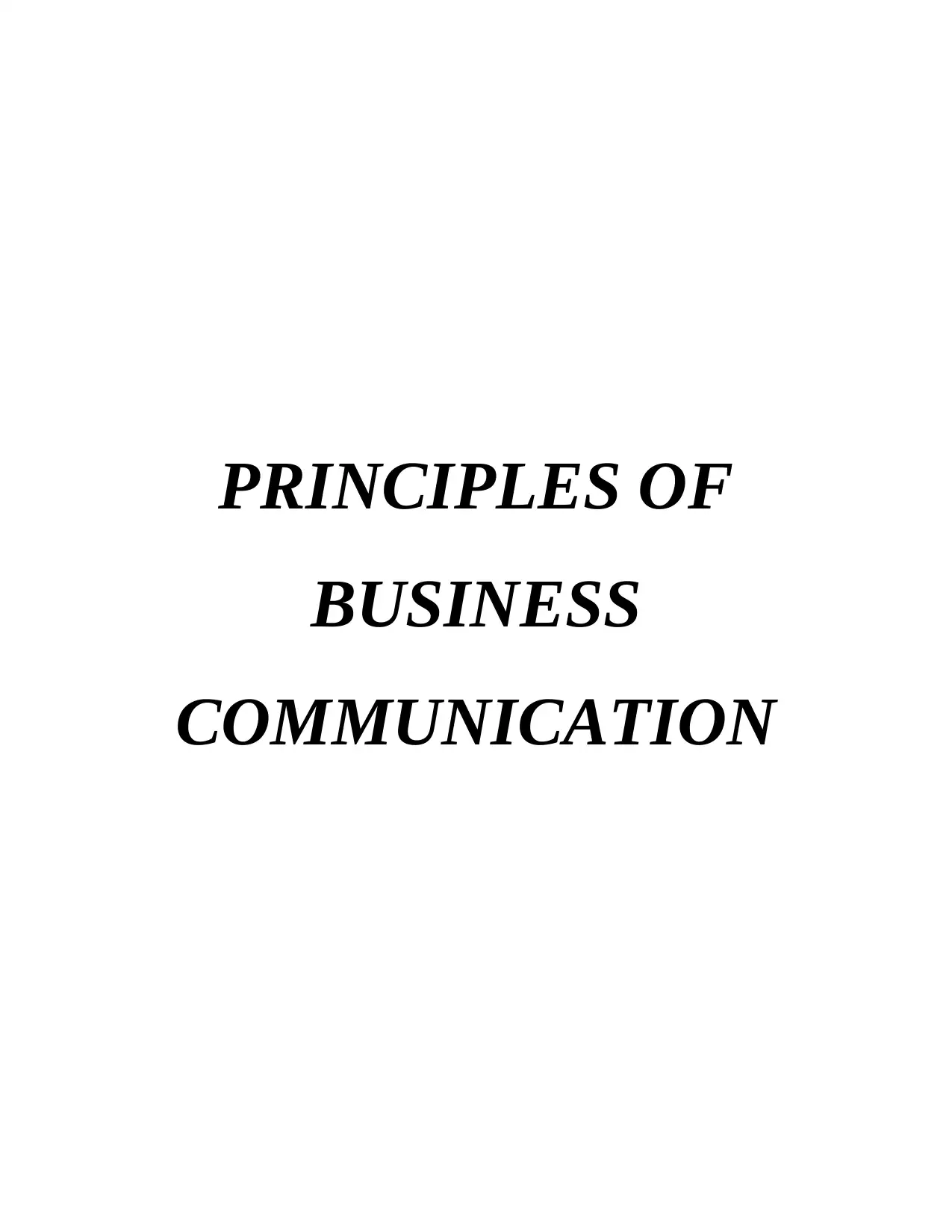
PRINCIPLES OF
BUSINESS
COMMUNICATION
BUSINESS
COMMUNICATION
Paraphrase This Document
Need a fresh take? Get an instant paraphrase of this document with our AI Paraphraser
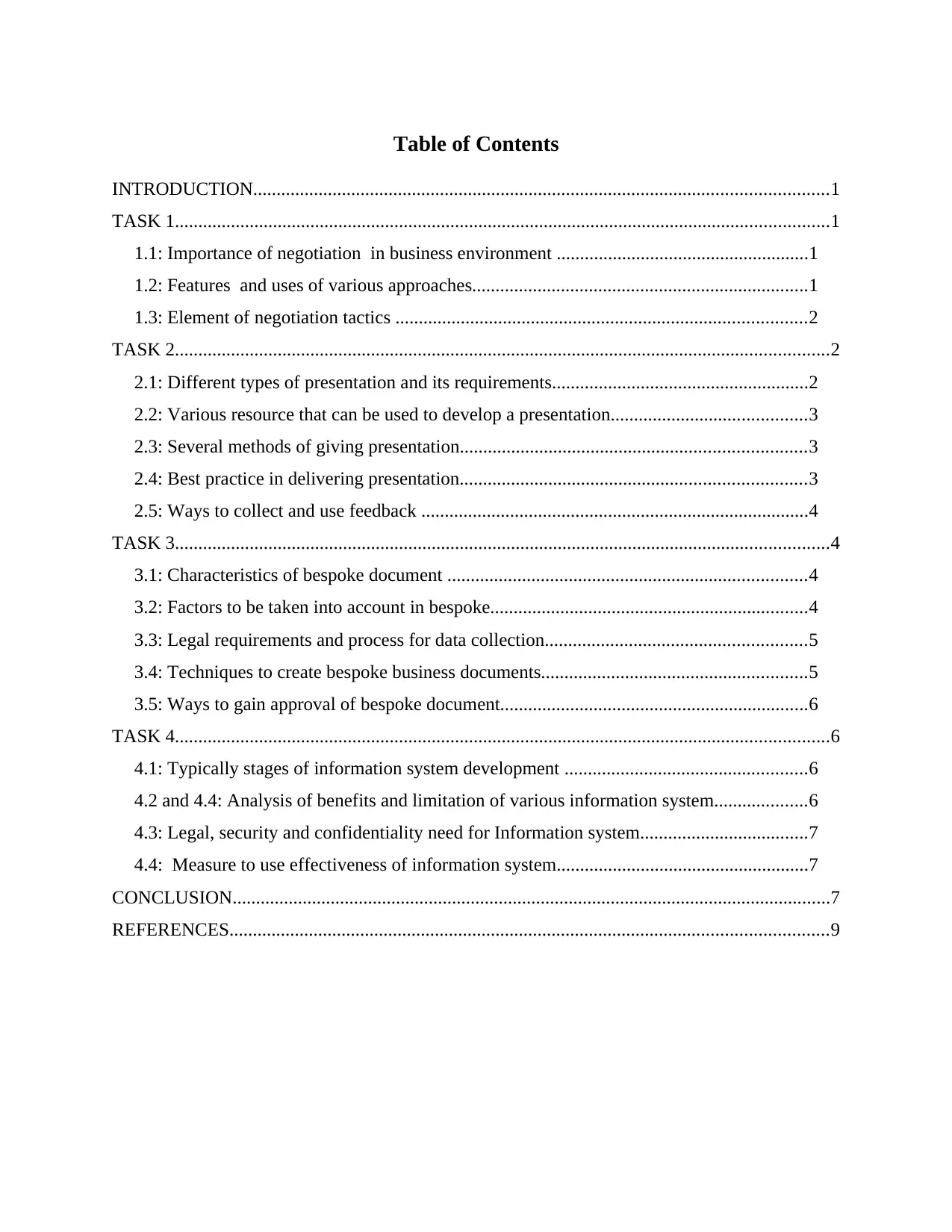
Table of Contents
INTRODUCTION...........................................................................................................................1
TASK 1............................................................................................................................................1
1.1: Importance of negotiation in business environment ......................................................1
1.2: Features and uses of various approaches........................................................................1
1.3: Element of negotiation tactics ........................................................................................2
TASK 2............................................................................................................................................2
2.1: Different types of presentation and its requirements.......................................................2
2.2: Various resource that can be used to develop a presentation..........................................3
2.3: Several methods of giving presentation..........................................................................3
2.4: Best practice in delivering presentation..........................................................................3
2.5: Ways to collect and use feedback ...................................................................................4
TASK 3............................................................................................................................................4
3.1: Characteristics of bespoke document .............................................................................4
3.2: Factors to be taken into account in bespoke....................................................................4
3.3: Legal requirements and process for data collection........................................................5
3.4: Techniques to create bespoke business documents.........................................................5
3.5: Ways to gain approval of bespoke document..................................................................6
TASK 4............................................................................................................................................6
4.1: Typically stages of information system development ....................................................6
4.2 and 4.4: Analysis of benefits and limitation of various information system....................6
4.3: Legal, security and confidentiality need for Information system....................................7
4.4: Measure to use effectiveness of information system......................................................7
CONCLUSION................................................................................................................................7
REFERENCES................................................................................................................................9
INTRODUCTION...........................................................................................................................1
TASK 1............................................................................................................................................1
1.1: Importance of negotiation in business environment ......................................................1
1.2: Features and uses of various approaches........................................................................1
1.3: Element of negotiation tactics ........................................................................................2
TASK 2............................................................................................................................................2
2.1: Different types of presentation and its requirements.......................................................2
2.2: Various resource that can be used to develop a presentation..........................................3
2.3: Several methods of giving presentation..........................................................................3
2.4: Best practice in delivering presentation..........................................................................3
2.5: Ways to collect and use feedback ...................................................................................4
TASK 3............................................................................................................................................4
3.1: Characteristics of bespoke document .............................................................................4
3.2: Factors to be taken into account in bespoke....................................................................4
3.3: Legal requirements and process for data collection........................................................5
3.4: Techniques to create bespoke business documents.........................................................5
3.5: Ways to gain approval of bespoke document..................................................................6
TASK 4............................................................................................................................................6
4.1: Typically stages of information system development ....................................................6
4.2 and 4.4: Analysis of benefits and limitation of various information system....................6
4.3: Legal, security and confidentiality need for Information system....................................7
4.4: Measure to use effectiveness of information system......................................................7
CONCLUSION................................................................................................................................7
REFERENCES................................................................................................................................9

INTRODUCTION
Business communication is more effective way through one can share information from
one another. It can be both formal and informal. It is an idea or though that an individual wants
to transmit to other must be clear enough to understand by receiver. It is an essential to exchange
effectively in negotiations to ensure that organisation as well as individual goals can be attain in
best possible manner (Greer, 2012). This project report consists of various information about
negotiating advantages and approaches those are helpful in better communication system.
Various types of presentation and necessary resources those are used in development of
activities. Characteristics of bespoke documents and various factors those are affecting it are
discussed under this project report.
TASK 1
1.1: Importance of negotiation in business environment
Negotiation is a techniques which an individual settle after communicating with two
parties (Negotiation Skills, 2017). It is an agreement which reached while avoiding dispute and
grievance. In every business communication it is important to have proper balance between
every department so that necessary outcomes can be generated.
Importance:
Negotiate for Long-Term Career Success: It is importance of negotiation in business
when it comes to our starting salary and benefits. This change in mindset will permit
individual to notice the advantages of negotiation for helping them to gain the tools they
need to grow and boom in the future.
Negotiate individual role: These are the more personal and informal workplace
situations in which we negotiate for ourselves.
1.2: Features and uses of various approaches
There are various effective features of negotiation that can be useful in managing
performances of an organisation (Guffey and Loewy, 2012). Some of them are:
It is crucial for every negotiation need at least two parties.
Both parties are having pre-determine objectives.
Few predetermine aims and objectives are not shared by the parties.
Outcomes of negotiation can be satisfactory so that effective results can be attained.
1
Business communication is more effective way through one can share information from
one another. It can be both formal and informal. It is an idea or though that an individual wants
to transmit to other must be clear enough to understand by receiver. It is an essential to exchange
effectively in negotiations to ensure that organisation as well as individual goals can be attain in
best possible manner (Greer, 2012). This project report consists of various information about
negotiating advantages and approaches those are helpful in better communication system.
Various types of presentation and necessary resources those are used in development of
activities. Characteristics of bespoke documents and various factors those are affecting it are
discussed under this project report.
TASK 1
1.1: Importance of negotiation in business environment
Negotiation is a techniques which an individual settle after communicating with two
parties (Negotiation Skills, 2017). It is an agreement which reached while avoiding dispute and
grievance. In every business communication it is important to have proper balance between
every department so that necessary outcomes can be generated.
Importance:
Negotiate for Long-Term Career Success: It is importance of negotiation in business
when it comes to our starting salary and benefits. This change in mindset will permit
individual to notice the advantages of negotiation for helping them to gain the tools they
need to grow and boom in the future.
Negotiate individual role: These are the more personal and informal workplace
situations in which we negotiate for ourselves.
1.2: Features and uses of various approaches
There are various effective features of negotiation that can be useful in managing
performances of an organisation (Guffey and Loewy, 2012). Some of them are:
It is crucial for every negotiation need at least two parties.
Both parties are having pre-determine objectives.
Few predetermine aims and objectives are not shared by the parties.
Outcomes of negotiation can be satisfactory so that effective results can be attained.
1
⊘ This is a preview!⊘
Do you want full access?
Subscribe today to unlock all pages.

Trusted by 1+ million students worldwide
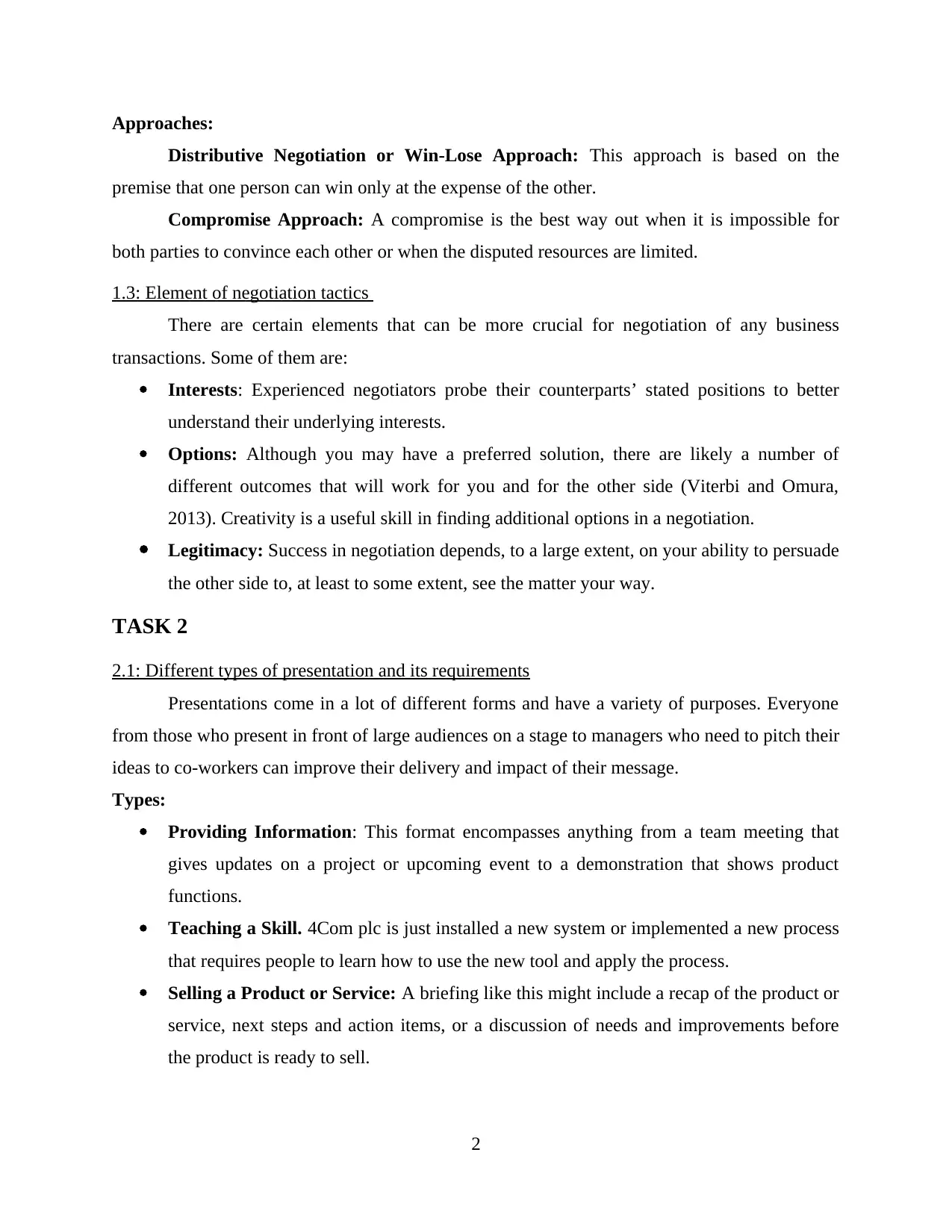
Approaches:
Distributive Negotiation or Win-Lose Approach: This approach is based on the
premise that one person can win only at the expense of the other.
Compromise Approach: A compromise is the best way out when it is impossible for
both parties to convince each other or when the disputed resources are limited.
1.3: Element of negotiation tactics
There are certain elements that can be more crucial for negotiation of any business
transactions. Some of them are:
Interests: Experienced negotiators probe their counterparts’ stated positions to better
understand their underlying interests.
Options: Although you may have a preferred solution, there are likely a number of
different outcomes that will work for you and for the other side (Viterbi and Omura,
2013). Creativity is a useful skill in finding additional options in a negotiation.
Legitimacy: Success in negotiation depends, to a large extent, on your ability to persuade
the other side to, at least to some extent, see the matter your way.
TASK 2
2.1: Different types of presentation and its requirements
Presentations come in a lot of different forms and have a variety of purposes. Everyone
from those who present in front of large audiences on a stage to managers who need to pitch their
ideas to co-workers can improve their delivery and impact of their message.
Types:
Providing Information: This format encompasses anything from a team meeting that
gives updates on a project or upcoming event to a demonstration that shows product
functions.
Teaching a Skill. 4Com plc is just installed a new system or implemented a new process
that requires people to learn how to use the new tool and apply the process.
Selling a Product or Service: A briefing like this might include a recap of the product or
service, next steps and action items, or a discussion of needs and improvements before
the product is ready to sell.
2
Distributive Negotiation or Win-Lose Approach: This approach is based on the
premise that one person can win only at the expense of the other.
Compromise Approach: A compromise is the best way out when it is impossible for
both parties to convince each other or when the disputed resources are limited.
1.3: Element of negotiation tactics
There are certain elements that can be more crucial for negotiation of any business
transactions. Some of them are:
Interests: Experienced negotiators probe their counterparts’ stated positions to better
understand their underlying interests.
Options: Although you may have a preferred solution, there are likely a number of
different outcomes that will work for you and for the other side (Viterbi and Omura,
2013). Creativity is a useful skill in finding additional options in a negotiation.
Legitimacy: Success in negotiation depends, to a large extent, on your ability to persuade
the other side to, at least to some extent, see the matter your way.
TASK 2
2.1: Different types of presentation and its requirements
Presentations come in a lot of different forms and have a variety of purposes. Everyone
from those who present in front of large audiences on a stage to managers who need to pitch their
ideas to co-workers can improve their delivery and impact of their message.
Types:
Providing Information: This format encompasses anything from a team meeting that
gives updates on a project or upcoming event to a demonstration that shows product
functions.
Teaching a Skill. 4Com plc is just installed a new system or implemented a new process
that requires people to learn how to use the new tool and apply the process.
Selling a Product or Service: A briefing like this might include a recap of the product or
service, next steps and action items, or a discussion of needs and improvements before
the product is ready to sell.
2
Paraphrase This Document
Need a fresh take? Get an instant paraphrase of this document with our AI Paraphraser

Reporting Progress: As managers integrate the new system into your daily routine,
company's boss wants to know how it’s working.
2.2: Various resource that can be used to develop a presentation
The format need to be selected before making any effective presentation (Leathers and
Eaves, 2015). There are some crucial guidelines to be implemented to ensure memorable and
conveys the message to other. The message is more fine chances of getting more positive
outcomes is more. Some of them are:
Keep it short and sweet: Use presentation slides to highlight key messages and topics
using as little text as possible.
Style tastefully: A pleasing design and focused layout can help define the overall
purpose of your presentation.
Use bold typography and proper hierarchy: Presentation must be readable on a variety
of devices.
2.3: Several methods of giving presentation
There are various techniques that can help in generating more effective outcomes for
4com plc. Some of them are:
Lecture: It is applicable to large assembled group such as in school and college etc.
Seminar: Such kind of tools are more useful in medium group with interactions of
business communication.
Discussion: It is mainly used in small organization which not huge transactions are done.
Forum - Under this company select a presenters with question which are being answered
by other people.
2.4: Best practice in delivering presentation
Speak clearly: This is always important, but critical when speaking to global audiences.
Vary pitch/speed: Use the same kinds of inflection that you would use in every day
conversation, but speak slightly slower than your normal pace.
Pause for emphasis: If you make a really important point pause for a moment to give
your audience time to process it.
3
company's boss wants to know how it’s working.
2.2: Various resource that can be used to develop a presentation
The format need to be selected before making any effective presentation (Leathers and
Eaves, 2015). There are some crucial guidelines to be implemented to ensure memorable and
conveys the message to other. The message is more fine chances of getting more positive
outcomes is more. Some of them are:
Keep it short and sweet: Use presentation slides to highlight key messages and topics
using as little text as possible.
Style tastefully: A pleasing design and focused layout can help define the overall
purpose of your presentation.
Use bold typography and proper hierarchy: Presentation must be readable on a variety
of devices.
2.3: Several methods of giving presentation
There are various techniques that can help in generating more effective outcomes for
4com plc. Some of them are:
Lecture: It is applicable to large assembled group such as in school and college etc.
Seminar: Such kind of tools are more useful in medium group with interactions of
business communication.
Discussion: It is mainly used in small organization which not huge transactions are done.
Forum - Under this company select a presenters with question which are being answered
by other people.
2.4: Best practice in delivering presentation
Speak clearly: This is always important, but critical when speaking to global audiences.
Vary pitch/speed: Use the same kinds of inflection that you would use in every day
conversation, but speak slightly slower than your normal pace.
Pause for emphasis: If you make a really important point pause for a moment to give
your audience time to process it.
3
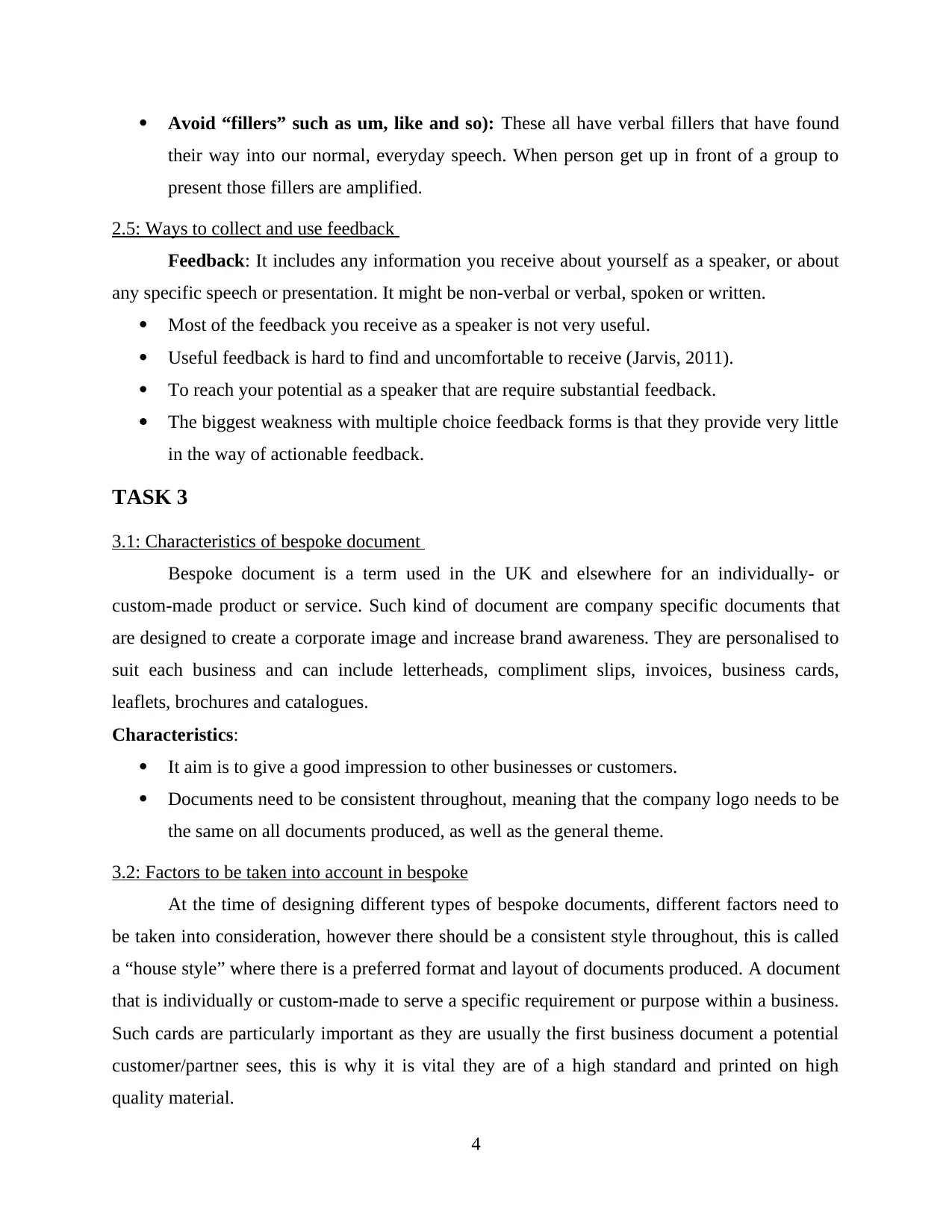
Avoid “fillers” such as um, like and so): These all have verbal fillers that have found
their way into our normal, everyday speech. When person get up in front of a group to
present those fillers are amplified.
2.5: Ways to collect and use feedback
Feedback: It includes any information you receive about yourself as a speaker, or about
any specific speech or presentation. It might be non-verbal or verbal, spoken or written.
Most of the feedback you receive as a speaker is not very useful.
Useful feedback is hard to find and uncomfortable to receive (Jarvis, 2011).
To reach your potential as a speaker that are require substantial feedback.
The biggest weakness with multiple choice feedback forms is that they provide very little
in the way of actionable feedback.
TASK 3
3.1: Characteristics of bespoke document
Bespoke document is a term used in the UK and elsewhere for an individually- or
custom-made product or service. Such kind of document are company specific documents that
are designed to create a corporate image and increase brand awareness. They are personalised to
suit each business and can include letterheads, compliment slips, invoices, business cards,
leaflets, brochures and catalogues.
Characteristics:
It aim is to give a good impression to other businesses or customers.
Documents need to be consistent throughout, meaning that the company logo needs to be
the same on all documents produced, as well as the general theme.
3.2: Factors to be taken into account in bespoke
At the time of designing different types of bespoke documents, different factors need to
be taken into consideration, however there should be a consistent style throughout, this is called
a “house style” where there is a preferred format and layout of documents produced. A document
that is individually or custom-made to serve a specific requirement or purpose within a business.
Such cards are particularly important as they are usually the first business document a potential
customer/partner sees, this is why it is vital they are of a high standard and printed on high
quality material.
4
their way into our normal, everyday speech. When person get up in front of a group to
present those fillers are amplified.
2.5: Ways to collect and use feedback
Feedback: It includes any information you receive about yourself as a speaker, or about
any specific speech or presentation. It might be non-verbal or verbal, spoken or written.
Most of the feedback you receive as a speaker is not very useful.
Useful feedback is hard to find and uncomfortable to receive (Jarvis, 2011).
To reach your potential as a speaker that are require substantial feedback.
The biggest weakness with multiple choice feedback forms is that they provide very little
in the way of actionable feedback.
TASK 3
3.1: Characteristics of bespoke document
Bespoke document is a term used in the UK and elsewhere for an individually- or
custom-made product or service. Such kind of document are company specific documents that
are designed to create a corporate image and increase brand awareness. They are personalised to
suit each business and can include letterheads, compliment slips, invoices, business cards,
leaflets, brochures and catalogues.
Characteristics:
It aim is to give a good impression to other businesses or customers.
Documents need to be consistent throughout, meaning that the company logo needs to be
the same on all documents produced, as well as the general theme.
3.2: Factors to be taken into account in bespoke
At the time of designing different types of bespoke documents, different factors need to
be taken into consideration, however there should be a consistent style throughout, this is called
a “house style” where there is a preferred format and layout of documents produced. A document
that is individually or custom-made to serve a specific requirement or purpose within a business.
Such cards are particularly important as they are usually the first business document a potential
customer/partner sees, this is why it is vital they are of a high standard and printed on high
quality material.
4
⊘ This is a preview!⊘
Do you want full access?
Subscribe today to unlock all pages.

Trusted by 1+ million students worldwide
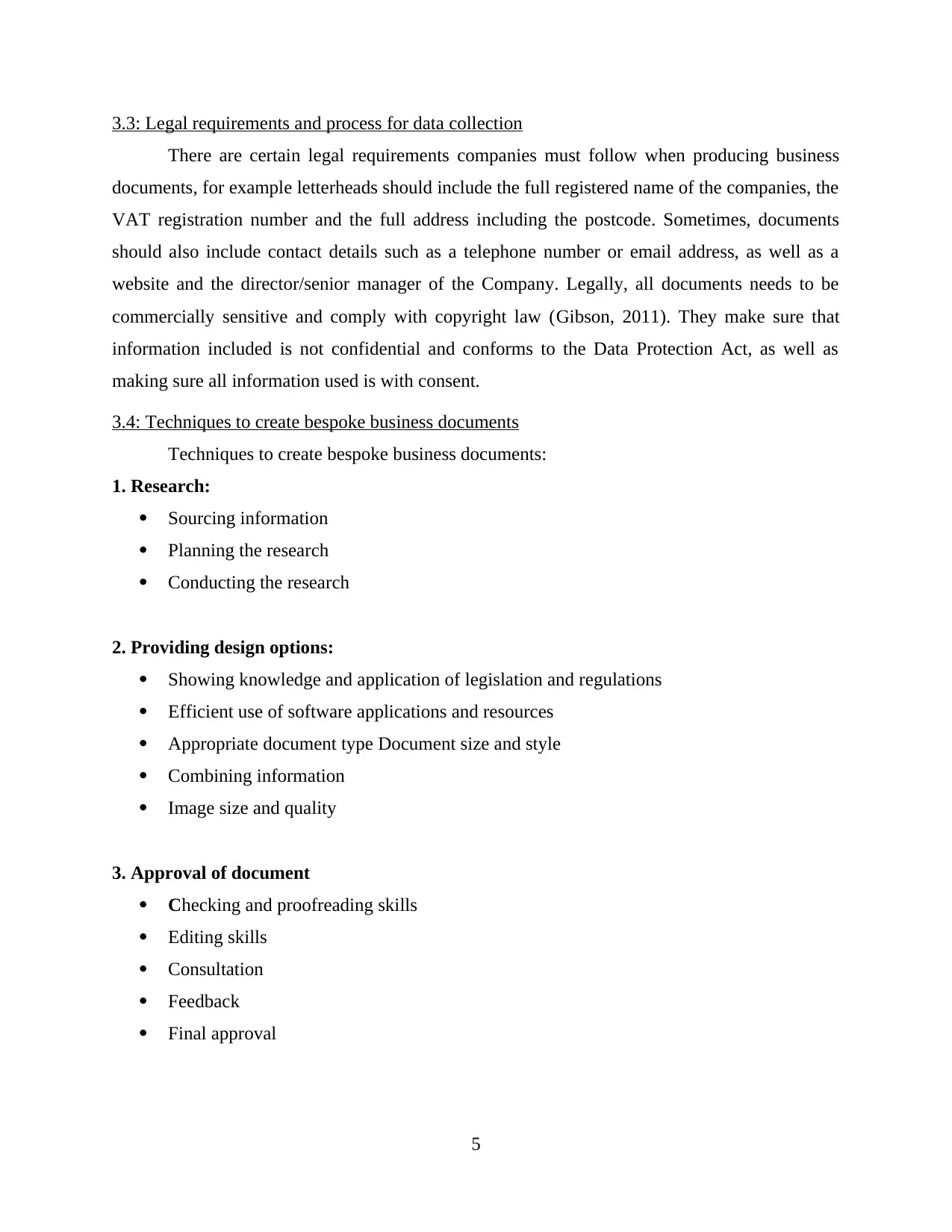
3.3: Legal requirements and process for data collection
There are certain legal requirements companies must follow when producing business
documents, for example letterheads should include the full registered name of the companies, the
VAT registration number and the full address including the postcode. Sometimes, documents
should also include contact details such as a telephone number or email address, as well as a
website and the director/senior manager of the Company. Legally, all documents needs to be
commercially sensitive and comply with copyright law (Gibson, 2011). They make sure that
information included is not confidential and conforms to the Data Protection Act, as well as
making sure all information used is with consent.
3.4: Techniques to create bespoke business documents
Techniques to create bespoke business documents:
1. Research:
Sourcing information
Planning the research
Conducting the research
2. Providing design options:
Showing knowledge and application of legislation and regulations
Efficient use of software applications and resources
Appropriate document type Document size and style
Combining information
Image size and quality
3. Approval of document
Checking and proofreading skills
Editing skills
Consultation
Feedback
Final approval
5
There are certain legal requirements companies must follow when producing business
documents, for example letterheads should include the full registered name of the companies, the
VAT registration number and the full address including the postcode. Sometimes, documents
should also include contact details such as a telephone number or email address, as well as a
website and the director/senior manager of the Company. Legally, all documents needs to be
commercially sensitive and comply with copyright law (Gibson, 2011). They make sure that
information included is not confidential and conforms to the Data Protection Act, as well as
making sure all information used is with consent.
3.4: Techniques to create bespoke business documents
Techniques to create bespoke business documents:
1. Research:
Sourcing information
Planning the research
Conducting the research
2. Providing design options:
Showing knowledge and application of legislation and regulations
Efficient use of software applications and resources
Appropriate document type Document size and style
Combining information
Image size and quality
3. Approval of document
Checking and proofreading skills
Editing skills
Consultation
Feedback
Final approval
5
Paraphrase This Document
Need a fresh take? Get an instant paraphrase of this document with our AI Paraphraser
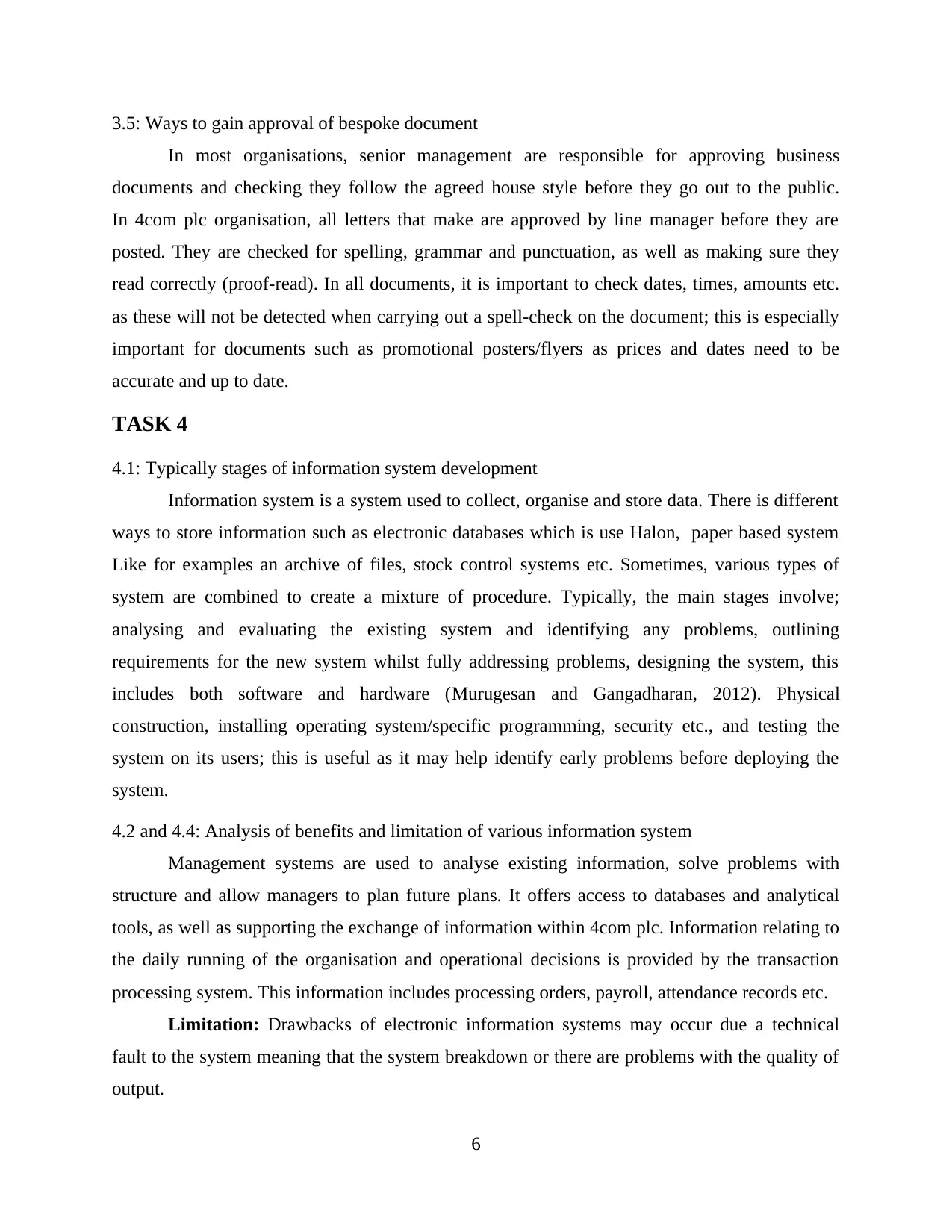
3.5: Ways to gain approval of bespoke document
In most organisations, senior management are responsible for approving business
documents and checking they follow the agreed house style before they go out to the public.
In 4com plc organisation, all letters that make are approved by line manager before they are
posted. They are checked for spelling, grammar and punctuation, as well as making sure they
read correctly (proof-read). In all documents, it is important to check dates, times, amounts etc.
as these will not be detected when carrying out a spell-check on the document; this is especially
important for documents such as promotional posters/flyers as prices and dates need to be
accurate and up to date.
TASK 4
4.1: Typically stages of information system development
Information system is a system used to collect, organise and store data. There is different
ways to store information such as electronic databases which is use Halon, paper based system
Like for examples an archive of files, stock control systems etc. Sometimes, various types of
system are combined to create a mixture of procedure. Typically, the main stages involve;
analysing and evaluating the existing system and identifying any problems, outlining
requirements for the new system whilst fully addressing problems, designing the system, this
includes both software and hardware (Murugesan and Gangadharan, 2012). Physical
construction, installing operating system/specific programming, security etc., and testing the
system on its users; this is useful as it may help identify early problems before deploying the
system.
4.2 and 4.4: Analysis of benefits and limitation of various information system
Management systems are used to analyse existing information, solve problems with
structure and allow managers to plan future plans. It offers access to databases and analytical
tools, as well as supporting the exchange of information within 4com plc. Information relating to
the daily running of the organisation and operational decisions is provided by the transaction
processing system. This information includes processing orders, payroll, attendance records etc.
Limitation: Drawbacks of electronic information systems may occur due a technical
fault to the system meaning that the system breakdown or there are problems with the quality of
output.
6
In most organisations, senior management are responsible for approving business
documents and checking they follow the agreed house style before they go out to the public.
In 4com plc organisation, all letters that make are approved by line manager before they are
posted. They are checked for spelling, grammar and punctuation, as well as making sure they
read correctly (proof-read). In all documents, it is important to check dates, times, amounts etc.
as these will not be detected when carrying out a spell-check on the document; this is especially
important for documents such as promotional posters/flyers as prices and dates need to be
accurate and up to date.
TASK 4
4.1: Typically stages of information system development
Information system is a system used to collect, organise and store data. There is different
ways to store information such as electronic databases which is use Halon, paper based system
Like for examples an archive of files, stock control systems etc. Sometimes, various types of
system are combined to create a mixture of procedure. Typically, the main stages involve;
analysing and evaluating the existing system and identifying any problems, outlining
requirements for the new system whilst fully addressing problems, designing the system, this
includes both software and hardware (Murugesan and Gangadharan, 2012). Physical
construction, installing operating system/specific programming, security etc., and testing the
system on its users; this is useful as it may help identify early problems before deploying the
system.
4.2 and 4.4: Analysis of benefits and limitation of various information system
Management systems are used to analyse existing information, solve problems with
structure and allow managers to plan future plans. It offers access to databases and analytical
tools, as well as supporting the exchange of information within 4com plc. Information relating to
the daily running of the organisation and operational decisions is provided by the transaction
processing system. This information includes processing orders, payroll, attendance records etc.
Limitation: Drawbacks of electronic information systems may occur due a technical
fault to the system meaning that the system breakdown or there are problems with the quality of
output.
6
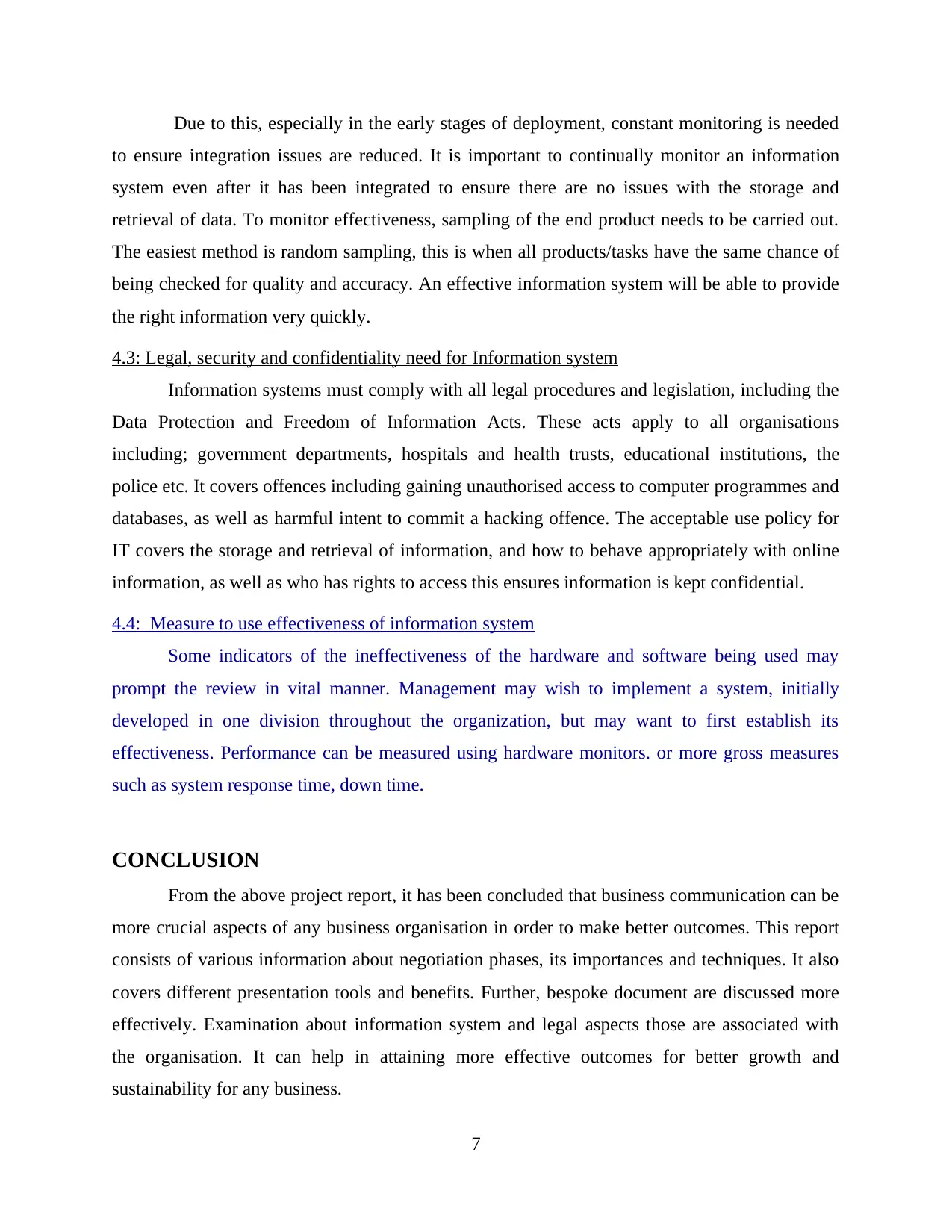
Due to this, especially in the early stages of deployment, constant monitoring is needed
to ensure integration issues are reduced. It is important to continually monitor an information
system even after it has been integrated to ensure there are no issues with the storage and
retrieval of data. To monitor effectiveness, sampling of the end product needs to be carried out.
The easiest method is random sampling, this is when all products/tasks have the same chance of
being checked for quality and accuracy. An effective information system will be able to provide
the right information very quickly.
4.3: Legal, security and confidentiality need for Information system
Information systems must comply with all legal procedures and legislation, including the
Data Protection and Freedom of Information Acts. These acts apply to all organisations
including; government departments, hospitals and health trusts, educational institutions, the
police etc. It covers offences including gaining unauthorised access to computer programmes and
databases, as well as harmful intent to commit a hacking offence. The acceptable use policy for
IT covers the storage and retrieval of information, and how to behave appropriately with online
information, as well as who has rights to access this ensures information is kept confidential.
4.4: Measure to use effectiveness of information system
Some indicators of the ineffectiveness of the hardware and software being used may
prompt the review in vital manner. Management may wish to implement a system, initially
developed in one division throughout the organization, but may want to first establish its
effectiveness. Performance can be measured using hardware monitors. or more gross measures
such as system response time, down time.
CONCLUSION
From the above project report, it has been concluded that business communication can be
more crucial aspects of any business organisation in order to make better outcomes. This report
consists of various information about negotiation phases, its importances and techniques. It also
covers different presentation tools and benefits. Further, bespoke document are discussed more
effectively. Examination about information system and legal aspects those are associated with
the organisation. It can help in attaining more effective outcomes for better growth and
sustainability for any business.
7
to ensure integration issues are reduced. It is important to continually monitor an information
system even after it has been integrated to ensure there are no issues with the storage and
retrieval of data. To monitor effectiveness, sampling of the end product needs to be carried out.
The easiest method is random sampling, this is when all products/tasks have the same chance of
being checked for quality and accuracy. An effective information system will be able to provide
the right information very quickly.
4.3: Legal, security and confidentiality need for Information system
Information systems must comply with all legal procedures and legislation, including the
Data Protection and Freedom of Information Acts. These acts apply to all organisations
including; government departments, hospitals and health trusts, educational institutions, the
police etc. It covers offences including gaining unauthorised access to computer programmes and
databases, as well as harmful intent to commit a hacking offence. The acceptable use policy for
IT covers the storage and retrieval of information, and how to behave appropriately with online
information, as well as who has rights to access this ensures information is kept confidential.
4.4: Measure to use effectiveness of information system
Some indicators of the ineffectiveness of the hardware and software being used may
prompt the review in vital manner. Management may wish to implement a system, initially
developed in one division throughout the organization, but may want to first establish its
effectiveness. Performance can be measured using hardware monitors. or more gross measures
such as system response time, down time.
CONCLUSION
From the above project report, it has been concluded that business communication can be
more crucial aspects of any business organisation in order to make better outcomes. This report
consists of various information about negotiation phases, its importances and techniques. It also
covers different presentation tools and benefits. Further, bespoke document are discussed more
effectively. Examination about information system and legal aspects those are associated with
the organisation. It can help in attaining more effective outcomes for better growth and
sustainability for any business.
7
⊘ This is a preview!⊘
Do you want full access?
Subscribe today to unlock all pages.

Trusted by 1+ million students worldwide

8
Paraphrase This Document
Need a fresh take? Get an instant paraphrase of this document with our AI Paraphraser
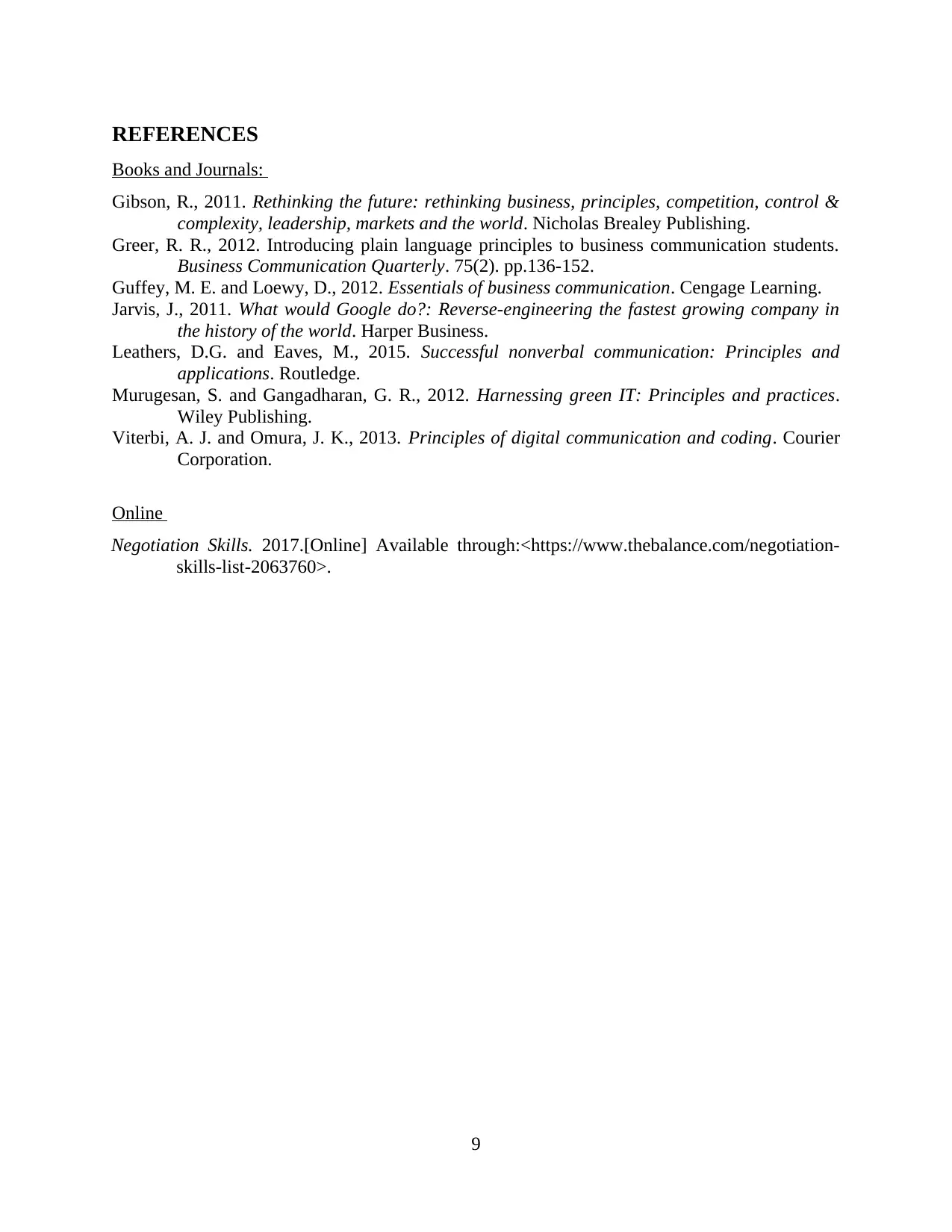
REFERENCES
Books and Journals:
Gibson, R., 2011. Rethinking the future: rethinking business, principles, competition, control &
complexity, leadership, markets and the world. Nicholas Brealey Publishing.
Greer, R. R., 2012. Introducing plain language principles to business communication students.
Business Communication Quarterly. 75(2). pp.136-152.
Guffey, M. E. and Loewy, D., 2012. Essentials of business communication. Cengage Learning.
Jarvis, J., 2011. What would Google do?: Reverse-engineering the fastest growing company in
the history of the world. Harper Business.
Leathers, D.G. and Eaves, M., 2015. Successful nonverbal communication: Principles and
applications. Routledge.
Murugesan, S. and Gangadharan, G. R., 2012. Harnessing green IT: Principles and practices.
Wiley Publishing.
Viterbi, A. J. and Omura, J. K., 2013. Principles of digital communication and coding. Courier
Corporation.
Online
Negotiation Skills. 2017.[Online] Available through:<https://www.thebalance.com/negotiation-
skills-list-2063760>.
9
Books and Journals:
Gibson, R., 2011. Rethinking the future: rethinking business, principles, competition, control &
complexity, leadership, markets and the world. Nicholas Brealey Publishing.
Greer, R. R., 2012. Introducing plain language principles to business communication students.
Business Communication Quarterly. 75(2). pp.136-152.
Guffey, M. E. and Loewy, D., 2012. Essentials of business communication. Cengage Learning.
Jarvis, J., 2011. What would Google do?: Reverse-engineering the fastest growing company in
the history of the world. Harper Business.
Leathers, D.G. and Eaves, M., 2015. Successful nonverbal communication: Principles and
applications. Routledge.
Murugesan, S. and Gangadharan, G. R., 2012. Harnessing green IT: Principles and practices.
Wiley Publishing.
Viterbi, A. J. and Omura, J. K., 2013. Principles of digital communication and coding. Courier
Corporation.
Online
Negotiation Skills. 2017.[Online] Available through:<https://www.thebalance.com/negotiation-
skills-list-2063760>.
9
1 out of 11
Related Documents
Your All-in-One AI-Powered Toolkit for Academic Success.
+13062052269
info@desklib.com
Available 24*7 on WhatsApp / Email
![[object Object]](/_next/static/media/star-bottom.7253800d.svg)
Unlock your academic potential
Copyright © 2020–2025 A2Z Services. All Rights Reserved. Developed and managed by ZUCOL.





